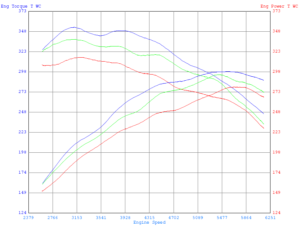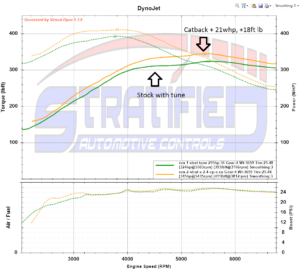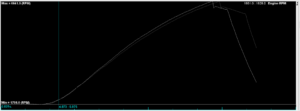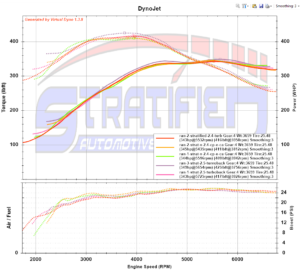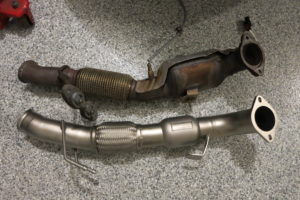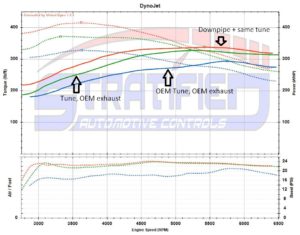With turbocharged cars, there are a few proven recipes to making power. One such recipe is to free up the exhaust. This does 2 things: It reduces pumping losses from the engine and it reduces the post-turbo exhaust pressure. This improves the turbine efficiency giving it the ability to spin the turbo faster and make more boost, faster. That means more power and a faster spool.
Back in the day, the engine controls and ECU were not fast or advanced enough to adapt to hardware changes made to the engine such as upgrading the exhaust. This combined with very restrictive emissions components (catalytic converters) and small diameter piping meant that throwing on a turboback exhaust resulted in big changes in boost pressures as well as power levels. Often, the turbos experienced boost creep and uncontrollable boost that led to cars running lean and damaging motors.
With modern cars things have changed quite a bit. First of all, the engine controls are a lot more sophisticated and faster acting. Boost and torque levels as well as fueling are monitored and targeted very closely by the ECU and tune. The exhaust systems are much better these days as well. Ford was able to extract 350hp from a 2.3 litre engine in factory trim and that means the exhaust system is a far cry from what was found on the turbo cars of the 1990s.
In order to extract performance from a modern turbo car you absolutely have to address the tune first and foremost. Without adjusting the ECU tune to enable the higher performance, adding flow hardware will have minimal effects on performance. Once the tune is on point, in a relentless pursuit for more horsepower we looked to the aftermarket to see what can be done with the exhaust system on the car.
The Focus RS has a single catalytic converter in the downpipe right after the turbo followed by a catback exhaust that is free flowing enough to add a nice burble with pops and bangs for good measure. The stock system diameter is 2.75″ which is an adequate diameter for stock power levels.
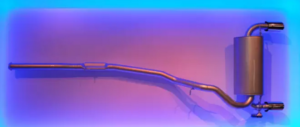 We started with a car that is bone stock and developed a Stratified tune built for 93 octane fuel. The tune maximizes what can be done on the stock hardware with the local 93 fuel. The vehicle was loaded on the dyno by our friends at Custom Performance Engineering with just the tune for a baseline. Below are the results on a Mustang dynamometer comparing stock (red), COBB OTS tune (green), and the Stratified custom tune (blue). It should be noted that this dyno is setup to mimic the acceleration of the car on the actual road very well. The airflow over the charge air cooler is not quite what we would see on the street but the car is loaded correctly to mimic a 4th gear run on the road. Because of this we were able to use data collected via the COBB Accessport very accurately.
We started with a car that is bone stock and developed a Stratified tune built for 93 octane fuel. The tune maximizes what can be done on the stock hardware with the local 93 fuel. The vehicle was loaded on the dyno by our friends at Custom Performance Engineering with just the tune for a baseline. Below are the results on a Mustang dynamometer comparing stock (red), COBB OTS tune (green), and the Stratified custom tune (blue). It should be noted that this dyno is setup to mimic the acceleration of the car on the actual road very well. The airflow over the charge air cooler is not quite what we would see on the street but the car is loaded correctly to mimic a 4th gear run on the road. Because of this we were able to use data collected via the COBB Accessport very accurately.
Once the baseline was established, the first part added to the car is a beautifully built full 3″ exhaust system made by the good people at Custom Performance Engineering. The car was loaded on the dyno for another set of runs. We used data from the Accessport collected on the dyno and the Virtual Dyno software for the next comparison.
In this case, while maintaining the same torque targets in the tune the car made an additional ~20whp, ~18wtq. Analyzing the acceleration data further, you can see how with a catback exhaust the car gets to redline around 0.6 seconds quicker.
The torque targets, timing, charge air temperatures, and fueling were the same between these runs. However fuel trims tell us a little bit more about what is going on. They indicated that the ECU had to add 1-2% more fuel to achieve the same air fuel ratios with the catback versus the bone stock car. This means the catback actually improved the volumetric efficiency of the engine. This means more air was entering the cylinders and producing more power. This, along with a drop in pumping losses accounts for the performance gains. We were pleasantly surprised to see this much of a difference from the catback exhaust but it was consistent across multiple runs.
The next part installed was an off-road catless downpipe replacing the OEM catalytic converter and downpipe. Again, keeping the same tune, multiple runs were made with the car and we found negligible differences in performance versus the stock downpipe with the aftermarket catback.
In this case from the exhaust standpoint we seemed to have reached the point of diminishing returns from a flow and pumping loss standpoint. Good job Ford on a well flowing downpipe! But wait … there is more to this. On closer analysis of the data, it’s evident that the wastegate is telling us of some gains achieved from the downpipe. The average wastegate duty cycle after the downpipe install during the entire run was 10% lower than with just a catback. You can visually see this difference especially near the end of the run.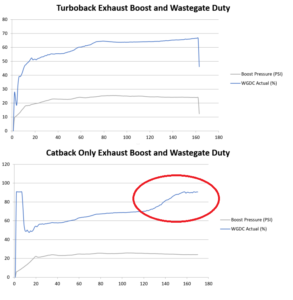
This means that there is a larger pressure differential across the turbine. This in turn means that should we want to, we CAN run more boost, especially in the top end and make more power. The ECU is controlling the wastegate very precisely to hit the targets in the tune, but we can then adjust the tune for more boost.
So why didn’t we? The reason is because we are at the knock limit of this fuel especially given the OEM intercooler still being installed. Running more boost would only result in knock, an unhappy engine, and no power gained. We will be back for more with a larger intercooler and higher octane fuel.
So what have we learned here? We’ve seen that a catback exhaust results in a power gain from a volumetric efficiency and pumping loss decrease standpoint. We’ve also seen that while a downpipe did not result in more power, it does enable us to run more boost if the charge air cooling and fuel octane support it. In other words it enables more power with more supporting modifications.
Finally, we learned how precisely the ECU controls the engine in this vehicle and how important it is to have the tune on point in order to extract additional performance from your RS.
EDIT: In the initial test we installed the catback first and downpipe SECOND. We did the reverse with our development Focus RS.
We left the stock catback in place and replaced the OEM downpipe with a catted CPE downpipe. We saw similar gains to what we saw when we replaced the catback.
Reason for this: the engine gained power from less back pressure and a reduction of pumping losses. This has diminishing returns when both a downpipe and catback are installed. However the initial improvements are there whether this is done via the downpipe OR the catback. Below is a chart showing what was gained with the downpipe on the same tune (RED), versus a stock exhaust system with just a tune (GREEN) and an OEM RS with an OEM tune (BLUE). This is a different car from the one in the rest of the article and using 91 octane fuel with only other hardware modification being an intake air filter.
And below is a short video during the downpipe install
Thank you to the team at Custom Performance Engineering for the excellent data collection and quality parts!


